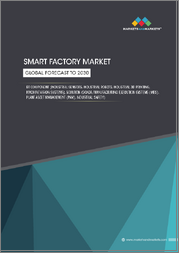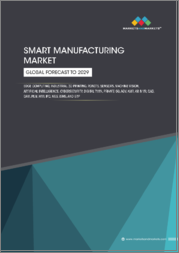
|
시장보고서
상품코드
1800249
산업용 3D 프린팅 시장 : 예측(2025-2030년)Industrial 3D Printing Market - Forecasts fom 2025 to 2030 |
||||||
산업용 3D 프린팅 시장은 25.79%의 연평균 복합 성장률(CAGR)로 성장할 전망이며, 2025년 42억 5,800만 달러에서 2030년에는 134억 900만 달러로 성장할 것으로 예측됩니다.
세계의 산업용 3D 프린팅 시장은 산업 부문의 확대, 3D 프린팅 기술의 비용 저하, 정부의 적극적인 대처에 의해 2025-2030년 강력한 성장이 전망되고 있습니다. 산업용 3D 프린팅, 즉 적층 제조는 복잡한 부품의 신속하고 민첩한 제조를 가능하게 하며 자동차, 항공우주, 의료 등 산업에서 혁신적인 설계 및 경량 재료의 기회를 설명합니다. 이 시장은 용융 적층 조형법(FDM)이나 레이저 금속 증착법(LMD) 등 기술의 진보에 더해 전문 지식과 인지도의 향상이 뒷받침하고 있습니다. 아시아태평양은 산업의 성장과 지원 시책에 힘입어 큰 시장 점유율을 차지할 것으로 예측됩니다. 과제로는 높은 초기 비용 및 기술적 한계 등을 들 수 있습니다.
시장 성장 촉진요인
산업 부문의 성장
자동차, 항공우주, 제조업을 중심으로 한 산업 분야의 세계 확대는 산업용 3D 프린팅 시장의 주요 촉진요인입니다. 가볍고 고정밀 부품을 생산할 수 있는 이 기술은 효율성을 높이고 재료 낭비를 없애줍니다. 인도에서는 2023년 생산량이 545만 대에 달한 자동차 분야의 성장이 복잡한 부품 제조, 품질 및 연비 향상에 대한 3D 프린팅 이용 증가를 뒷받침하고 있습니다. 이 동향은 산업이 수요 증가에 대응하기 위해 혁신적인 생산 방법을 모색하고 있기 때문에 시장 성장을 지원합니다.
비용 저하 및 기술 진보
3D 프린팅 머신의 비용 저하와 FDM이나 LMD 등의 기술의 진보가 보급을 뒷받침하고 있습니다. 향상된 용융막 형성 모델링은 복잡하고 가벼운 컴포넌트를 생산할 수 있게 해주며, AI 및 머신러닝 통합과 같은 혁신을 통해 인쇄 품질과 효율성을 향상시킵니다. 이러한 개발로 3D 프린팅은 중소기업에서도 이용하기 쉬워지고, 다양한 부문에서의 이용이 확대되고 개발이 가속화되고 있습니다.
정부의 적극적인 노력
3D 프린팅 도입에 대한 정부의 지원이 시장 확대를 가속화하고 있습니다. 정부와 산업 부문의 협력을 촉진하는 시책은 인도와 같은 지역을 3D 프린팅 개발의 허브로 확립하는 것을 목표로 하고 있습니다. 이러한 이니셔티브는 첨단 제조 기술에 대한 투자를 촉진하고 자동차 및 항공우주와 같은 산업의 혁신과 확장성을 촉진하며 산업용 3D 프린팅 솔루션에 대한 수요를 더욱 촉진하고 있습니다.
시장 성장 억제요인
산업용 3D 프린팅 시장은 장비와 재료의 초기 비용이 높다는 과제에 직면하고 있습니다. 또한 인쇄 속도 및 재료 호환성과 같은 기술적 제약은 대규모 생산의 확장성을 방해할 수 있습니다. 게다가 특히 신흥 시장에서는 3D 프린팅 시스템을 운영하고 최적화하는 숙련된 전문가의 부족이 장벽이 되고 있습니다. 지속적인 성장을 위해서는 비용 효율적인 기술과 인적 자원 개발을 통해 이러한 과제를 해결하는 것이 필수적입니다.
목차
제1장 주요 요약
제2장 시장 현황
- 시장 개요
- 시장 정의
- 조사 범위
- 시장 세분화
제3장 비즈니스 상황
- 시장 성장 촉진요인
- 시장 성장 억제요인
- 시장 기회
- Porter's Five Forces 분석
- 산업 밸류체인 분석
- 시책과 규제
- 전략적 제안
제4장 기술 전망
제5장 산업용 3D 프린팅 시장 : 컴포넌트별
- 서문
- 하드웨어
- 소프트웨어
- 서비스
제6장 산업용 3D프린팅 시장 : 재료별
- 서문
- 금속
- 폴리머
- 기타
제7장 산업용 3D 프린팅 시장 : 기술별
- 서문
- 스테레오 리소그래피
- 열용해 적층법
- 선택적 레이저 소결
- 직접 금속 레이저 소결
- 폴리젯 프린팅
- 잉크젯 프린팅
- 레이저 금속 증착
- 기타
제8장 산업용 3D 프린팅 시장 : 지역별
- 서문
- 북미
- 미국
- 캐나다
- 멕시코
- 남미
- 브라질
- 아르헨티나
- 기타
- 유럽
- 영국
- 독일
- 프랑스
- 스페인
- 기타
- 중동 및 아프리카
- 사우디아라비아
- 아랍에미리트(UAE)
- 이스라엘
- 기타
- 아시아태평양
- 일본
- 중국
- 인도
- 한국
- 인도네시아
- 태국
- 기타
제9장 경쟁 환경 및 분석
- 주요 기업 및 전략 분석
- 시장 점유율 분석
- 합병, 인수, 합의 및 콜라보레이션
- 경쟁 대시보드
제10장 기업 프로파일
- 3D Systems, Inc.
- Desktop Metal
- General Electric Company(GE Additive)
- Voxeljet AG
- Renishaw plc
- Stratasys Ltd.
- Nikon Corporation
- Materialise
- EOS Group
- HP Inc.
제11장 조사 방법
AJY 25.09.03The industrial 3D printing market is expected to grow from USD 4.258 billion in 2025 to USD 13.409 billion in 2030, at a CAGR of 25.79%.
The global industrial 3D printing market is poised for robust growth from 2025 to 2030, driven by the expanding industrial sector, declining costs of 3D printing technology, and favorable government initiatives. Industrial 3D printing, or additive manufacturing, enables rapid, agile production of complex components, offering opportunities for innovative designs and lightweight materials across industries like automotive, aerospace, and medical. The market is propelled by advancements in technologies such as fused deposition modeling (FDM) and laser metal deposition (LMD), alongside increasing expertise and awareness. Asia-Pacific is expected to hold a significant market share, fueled by industrial growth and supportive policies. Challenges include high initial costs and technical limitations.
Market Drivers
Growing Industrial Sector
The global expansion of industrial sectors, particularly automotive, aerospace, and manufacturing, is a primary driver of the industrial 3D printing market. The technology's ability to produce lightweight, high-precision components enhances efficiency and reduces material waste. In India, the automotive sector's growth, with production reaching 5.45 million units in 2023, underscores the increasing use of 3D printing for manufacturing complex parts, improving quality and fuel efficiency. This trend supports market growth as industries seek innovative production methods to meet rising demand.
Declining Costs and Technological Advancements
The declining cost of 3D printing machines, coupled with advancements in techniques like FDM and LMD, is driving widespread adoption. Improved fused deposition modeling enables the production of complex, lightweight components, while innovations like AI and machine learning integration enhance print quality and efficiency. These developments make 3D printing more accessible to small and medium enterprises, expanding its use across diverse sectors and boosting market growth.
Favorable Government Initiatives
Government support for 3D printing adoption is accelerating market expansion. Policies promoting collaboration between government and industrial sectors aim to establish regions like India as hubs for 3D printing development. Such initiatives encourage investment in advanced manufacturing technologies, fostering innovation and scalability in industries like automotive and aerospace, further driving demand for industrial 3D printing solutions.
Market Restraints
The industrial 3D printing market faces challenges due to high initial costs for equipment and materials, which can limit adoption among smaller firms. Technical limitations, such as print speed and material compatibility, may also hinder scalability for large-scale production. Additionally, a shortage of skilled professionals to operate and optimize 3D printing systems poses a barrier, particularly in emerging markets. Addressing these challenges through cost-effective technologies and workforce training will be critical for sustained growth.
Market Segmentation
By Technology
The market is segmented into stereolithography, fused deposition modeling (FDM), selective laser sintering, direct metal laser sintering, polyjet printing, inkjet printing, laser metal deposition (LMD), and others. Stereolithography and FDM hold significant shares due to their versatility in medical, dental, and automotive applications. LMD is gaining traction for its ability to repair and manufacture metal parts, particularly in aerospace and automotive sectors.
By Application
The market includes automotive, aerospace, medical, consumer goods, and others. Automotive and aerospace dominate, leveraging 3D printing for lightweight components and rapid prototyping. Medical applications are growing, driven by the production of custom implants and prosthetics.
By Geography
The market is segmented into North America, Europe, Asia-Pacific, South America, and the Middle East and Africa. Asia-Pacific is projected to hold a significant share, driven by industrial growth, automotive production, and government support in countries like India and China. North America and Europe are key markets, supported by advanced manufacturing ecosystems, while South America and the Middle East and Africa are emerging due to increasing industrial investments.
The industrial 3D printing market is set for robust growth from 2025 to 2030, driven by industrial expansion, declining technology costs, and supportive government policies. Despite challenges like high costs and technical limitations, the market's outlook is positive, particularly in Asia-Pacific. Industry players must focus on cost-effective innovations, advanced materials, and workforce development to capitalize on the growing demand for 3D printing in manufacturing high-quality, lightweight components across diverse sectors.
Key Benefits of this Report:
- Insightful Analysis: Gain detailed market insights covering major as well as emerging geographical regions, focusing on customer segments, government policies and socio-economic factors, consumer preferences, industry verticals, and other sub-segments.
- Competitive Landscape: Understand the strategic maneuvers employed by key players globally to understand possible market penetration with the correct strategy.
- Market Drivers & Future Trends: Explore the dynamic factors and pivotal market trends and how they will shape future market developments.
- Actionable Recommendations: Utilize the insights to exercise strategic decisions to uncover new business streams and revenues in a dynamic environment.
- Caters to a Wide Audience: Beneficial and cost-effective for startups, research institutions, consultants, SMEs, and large enterprises.
What do businesses use our reports for?
Industry and Market Insights, Opportunity Assessment, Product Demand Forecasting, Market Entry Strategy, Geographical Expansion, Capital Investment Decisions, Regulatory Framework & Implications, New Product Development, Competitive Intelligence
Report Coverage:
- Historical data from 2020 to 2024 & forecast data from 2025 to 2030
- Growth Opportunities, Challenges, Supply Chain Outlook, Regulatory Framework, and Trend Analysis
- Competitive Positioning, Strategies, and Market Share Analysis
- Revenue Growth and Forecast Assessment of segments and regions including countries
- Company Profiling (Strategies, Products, Financial Information, and Key Developments among others.
Segmentation:
BY COMPONENT
- Hardware
- Software
- Services
BY MATERIAL
- Metals
- Polymers
- Others
BY TECHNOLOGY
- Stereolithography
- Fused Deposition Modelling
- Selective Laser Sintering
- Direct Metal Laser Sintering
- Polyjet Printing
- Inkjet Printing
- Laser Metal Deposition
- Others
BY GEOGRAPHY
- North America
- USA
- Canada
- Mexico
- South America
- Brazil
- Argentina
- Others
- Europe
- Germany
- France
- UK
- Italy
- Others
- Asia-Pacific
- China
- India
- Japan
- South Korea
- Taiwan
- Thailand
- Indonesia
- Others
TABLE OF CONTENTS
1. EXECUTIVE SUMMARY
2. MARKET SNAPSHOT
- 2.1. Market Overview
- 2.2. Market Definition
- 2.3. Scope of the Study
- 2.4. Market Segmentation
3. BUSINESS LANDSCAPE
- 3.1. Market Drivers
- 3.2. Market Restraints
- 3.3. Market Opportunities
- 3.4. Porter's Five Forces Analysis
- 3.5. Industry Value Chain Analysis
- 3.6. Policies and Regulations
- 3.7. Strategic Recommendations
4. TECHNOLOGICAL OUTLOOK
5. INDUSTRIAL 3D PRINTING MARKET BY COMPONENT
- 5.1. Introduction
- 5.2. Hardware
- 5.3. Software
- 5.4. Services
6. INDUSTRIAL 3D PRINTING MARKET BY MATERIAL
- 6.1. Introduction
- 6.2. Metals
- 6.3. Polymers
- 6.4. Others
7. INDUSTRIAL 3D PRINTING MARKET BY TECHNOLOGY
- 7.1. Introduction
- 7.2. Stereolithography
- 7.3. Fused Deposition Modelling
- 7.4. Selective Laser Sintering
- 7.5. Direct Metal Laser Sintering
- 7.6. Polyjet Printing
- 7.7. Inkjet Printing
- 7.8. Laser Metal Deposition
- 7.9. Others
8. INDUSTRIAL 3D PRINTING MARKET BY GEOGRAPHY
- 8.1. Introduction
- 8.2. North America
- 8.2.1. USA
- 8.2.2. Canada
- 8.2.3. Mexico
- 8.3. South America
- 8.3.1. Brazil
- 8.3.2. Argentina
- 8.3.3. Others
- 8.4. Europe
- 8.4.1. United Kingdom
- 8.4.2. Germany
- 8.4.3. France
- 8.4.4. Spain
- 8.4.5. Others
- 8.5. Middle East & Africa
- 8.5.1. Saudi Arabia
- 8.5.2. UAE
- 8.5.3. Israel
- 8.5.4. Others
- 8.6. Asia Pacific
- 8.6.1. Japan
- 8.6.2. China
- 8.6.3. India
- 8.6.4. South Korea
- 8.6.5. Indonesia
- 8.6.6. Thailand
- 8.6.7. Others
9. COMPETITIVE ENVIRONMENT AND ANALYSIS
- 9.1. Major Players and Strategy Analysis
- 9.2. Market Share Analysis
- 9.3. Mergers, Acquisitions, Agreements, and Collaborations
- 9.4. Competitive Dashboard
10. COMPANY PROFILES
- 10.1. 3D Systems, Inc.
- 10.2. Desktop Metal
- 10.3. General Electric Company (GE Additive)
- 10.4. Voxeljet AG
- 10.5. Renishaw plc
- 10.6. Stratasys Ltd.
- 10.7. Nikon Corporation
- 10.8. Materialise
- 10.9. EOS Group
- 10.10. HP Inc.

















